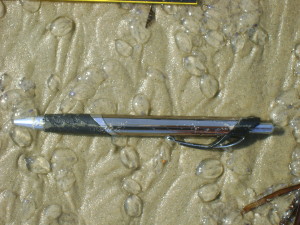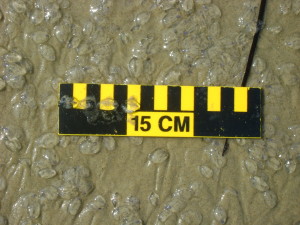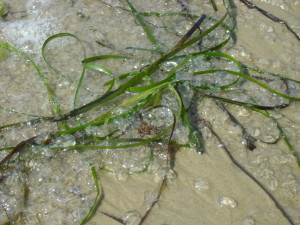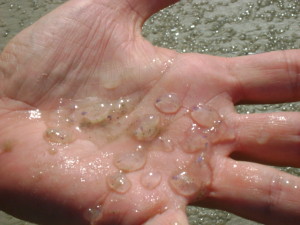Diamonds in the Surf
Note: “Science and Nature for a Pie” is now on Facebook! Visit www.facebook.com/scienceandnatureforapie and “like” the page for ongoing discussions, photos, and factoids!
Looking at them was like seeing diamonds scattered in the shoreline. They were translucent, and sparkled brilliantly in the wet sand as the sun caught them. There were thousands, perhaps tens of thousands, running the entire 1.5-mile length of Napatree Point Conservation Area. Shimmering, sparkling, a king’s riches lying on the sands, waiting to be picked up.
Trouble was, the moment they were picked up, it became obvious that these were as far from diamonds as you can get. The chains, the piles, the individuals quickly slipped through fingers. These were soft, gelatinous, and in some places there were so many that the journey from the sand to the water was a slick, slimy mess. Beach visitors said that in 50 years, they had never seen a phenomenon like this. Others said that they had witnessed a similar occurrence on Block Island just a day earlier. So if they weren’t diamonds, what in the world were they? Baby jellyfish? And where had they come from? After calling on experts from the science community, the identity of the sparkling gobs came back: salps.

A salp is a harmless, plankton-like animal that can be found either as individuals or joined in chains or clusters similar to those in the pictures. According to the Peterson Guide to the Atlantic Seashore, salps alternate between sexual and asexual generations. In their asexual forms, they appear in chains of sometimes hundreds at a time. As they mature, they divide into groups, then separate into solitary sexual individuals. Young develop within their mothers and are born as new (asexual) chains. They are usually found in warm offshore waters, and are considered rare north of Cape Cod. In addition, they are infrequent visitors to local beaches.

Some of the salps were still in chain form, while others were single or had had the chains broken by wave action.
If someone were trying to show the strange appearance just 48 hours later, they might have been thought to be seeing things. Just like that, the beach went from a nearly solid line of salps to none. What happened to them? In the intervening time, several factors had occurred that may have held an answer: first, the area (along with most of the state) had endured several inches of rain. Second, the occurrence coincided with a full (super) moon, which brings extreme tidal cycles. Third, the wind had changed direction. Finally, the previous day’s storms had brought heavy wave action and a likely change in currents. Where did they go?
Dr. Barbara K. Sullivan-Watts, a senior research scientist with URI’s Graduate School of Oceanography had this to say in an email query:
“I wish I could answer your questions! Even when we have studies going on to follow where the jellies come from or got to we do not always get answers! Many marine species have boom and bust years for reasons that are hard to pin down, especially if they can reproduce quickly in response to a good food year. But what is a good food year – even that can be hard to determine. And you are correct currents likely also sweep them in and out of a particular region.”
Thus, the mystery will only be partially solved. The diamonds sparkling in the sand were identified. How they got to Rhode Island’s shores and where they went afterward remains unknown. Climate change, food availability, chemical changes, happenstance: there are simply too many variables to be certain. Sometimes the correct answer is: we don’t know.








